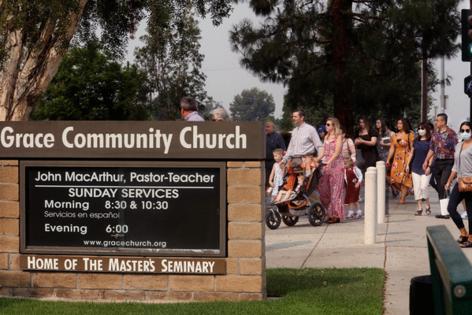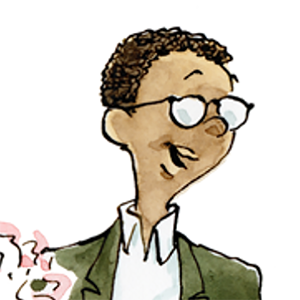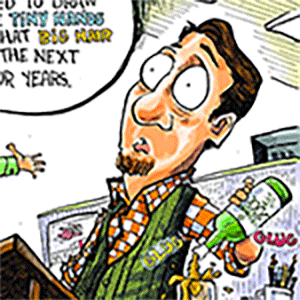Rev. John MacArthur, influential evangelical pastor of California megachurch, dies at 86
Published in News & Features
LOS ANGELES — The Rev. John MacArthur, among the country’s most influential evangelical pastors with a prolific media reach — and whose San Fernando Valley megachurch became the face of religious resistance to California’s COVID-19 public health orders — died Monday. He was 86.
MacArthur’s death was announced on the website of Grace Community Church in Sun Valley. He had recently contacted pneumonia, according to the church.
Franklin Graham, president of the Billy Graham Evangelistic Association, paid tribute to MacArthur on social media, calling him one of “America’s great Bible teachers.”
“He could get more out of a Bible verse than anyone I’ve ever known,” wrote Graham on X. “His voice will be greatly missed.”
Though based in Los Angeles — where his faithful filled a 3,500-seat auditorium twice every Sunday for his sermons — MacArthur reached millions of people internationally through his radio and television programs and books, and guided the lives of countless young theologians as president of the Master’s University and adjoining seminary in Santa Clarita.
He was known for his fundamentalist biblical standards, strictly focusing on the writings of the Scriptures and eschewing sermons that touched on more modern themes.
Grace Community Church said in a statement on its website this week that his “ministry was an unwavering commitment to declare God’s truth, and Pastor John preached the Word in season and out of season. Even in recent years, though beset with health challenges, he persisted in teaching, leading, and investing in the ministries the Lord had entrusted to him.”
From a family with a long line of pastors, MacArthur said he was always religious and described how a car accident in Alabama that left him in excruciating pain helped push him to the pulpit. As a freshman college student in South Carolina, he was sent for treatment to California, where doctors had to remove road asphalt from his severely damaged back.
“I had to lie in my bed on my stomach for about three months and let that all heal, at the end of which I really was ready to do whatever God wanted me to do,” he said in a 2004 interview posted by his media company. “And I knew by then I was going to preach and teach.”
MacArthur was born at St. Vincent’s Hospital in Los Angeles. His father, Jack, was a pastor of a Baptist church in South L.A. and would would soon branch into evangelism, which would take the family to Chicago and Philadelphia.
He attended Bob Jones University in Greenville, S.C., and then transferred to Los Angeles Pacific College. When he took the pulpit of Grace Community Church in 1969, Sunday attendance averaged about 700 people in the northern San Fernando Valley neighborhood.
His influence expanded as thousands of radio listeners tuned into “Grace to You,” his syndicated half-hour show, and he would later launch an extensive media outlet that broadcast his teachings to dozens of countries.
He became president of the Master’s College in 1985, which later changed its name to the Master’s University, and presided over unprecedented growth at the fundamentalist institution, The Times wrote in 1990. He helped oversee a seminary next door.
In 1997, The Times described how McArthur refused to use a typewriter or computer and painstakingly handwrote his Bible studies. “I don’t have time for the learning curve,” he said.
He wrote more than 400 books and study guides, including the ”The MacArthur Study Bible,” and appealed to ultraconservative churchgoers by adhering to fundamentalist biblical standards that focused on teaching an “inerrant” Bible — a dogma that sees the Bible as devoid of mistakes.
At the same time, he rejected the user-friendly sermons, rock music and community outreach that defined some evangelical churches in the 1980s and 1990s and took aim those who he said used gimmicks to attract people to church.
The church “is not a pub for the neighborhood,” he wrote in his 1993 book, “Ashamed of the Gospel: When the Church Becomes Like the World.” “It is not a community center where parties are held. It is not a country club for the masses.”
The Times covered his attacks on fellow clergy, writing in 1991 that MacArthur turned into the “enfant terrible of conservative Protestantism.”
Over the span of his career, he called Catholicism a “false religion,” criticized popular religious figures including Joel Osteen and Beth Moore, and called Black Lives Matter “an organization that is the enemy of God” because of its support of LGBTQ+ equality.
In recent years, at least two media outlets that cover religion — Christianity Today and the Roys Report — reported on allegations that women who sought biblical counseling over abusive marriages were advised by church elders to stay with their husbands and feared church discipline over the matter. The church did not respond to the allegations in the stories.
After the 2020 pandemic left religious institutions reliant on livestreams and outdoor gatherings, Grace Community Church continued to hold indoor services, with MacArthur questioning the existence of the coronavirus and challenging whether the government could restrict prayer practices.
County health inspectors who tried to enter the church where blocked by security guards.
“There is no pandemic,” MacArthur told his followers in August 2020, though later he would acknowledge the virus.
Los Angeles County sued the church but ultimately settled in the face of Supreme Court rulings that sided with religious institutions. In a 2021 letter to supporters, MacArthur announced the church’s legal fees would be paid. The church later received $800,000 from the state and county for the fees.
“We know that there is no circumstance that can cause the church to close,” he wrote in the letter. “The church is not only a building but is the bride of Christ and exists to proclaim the truth.”
MacArthur is survived by his wife, Patricia; four children; 15 grandchildren; and nine great-grandchildren.
_____
©2025 Los Angeles Times. Visit at latimes.com. Distributed by Tribune Content Agency, LLC.







Comments